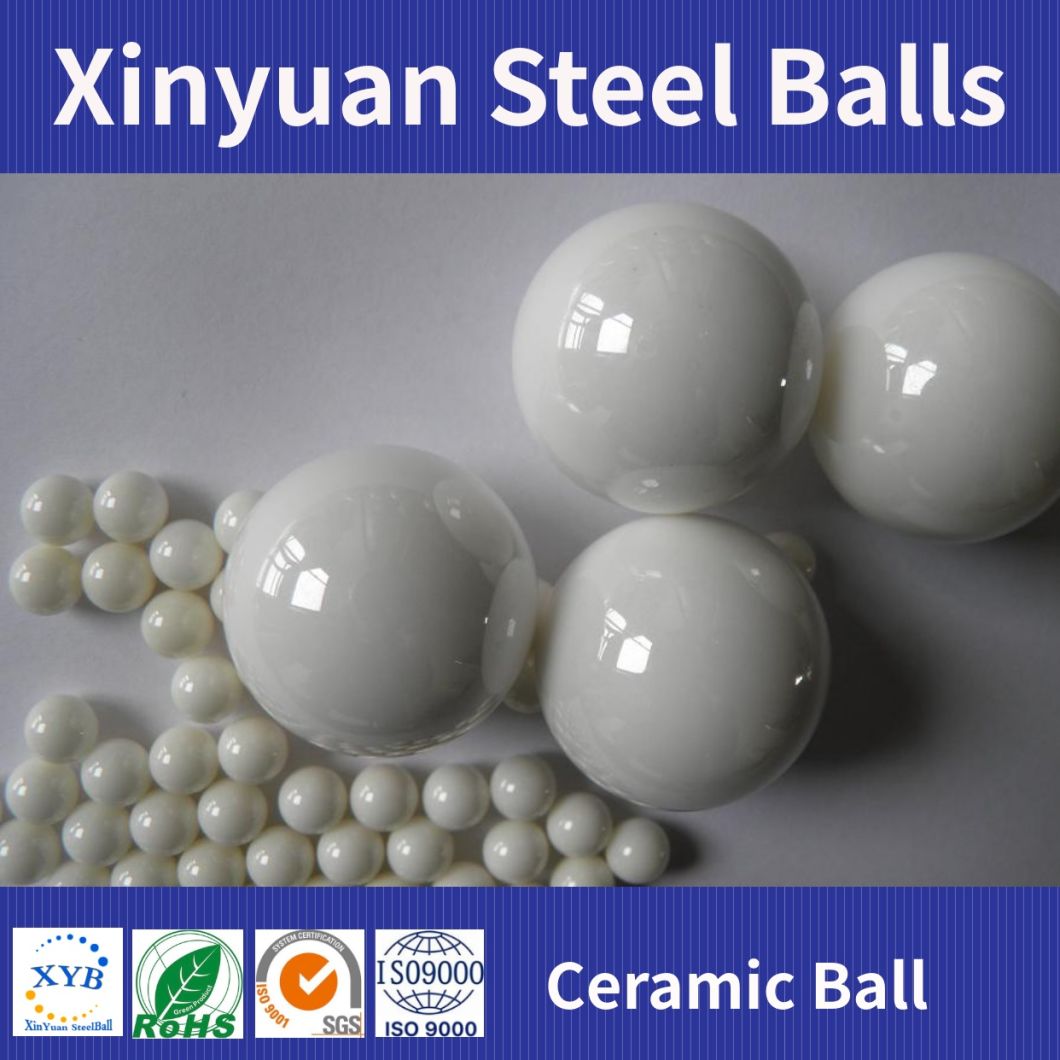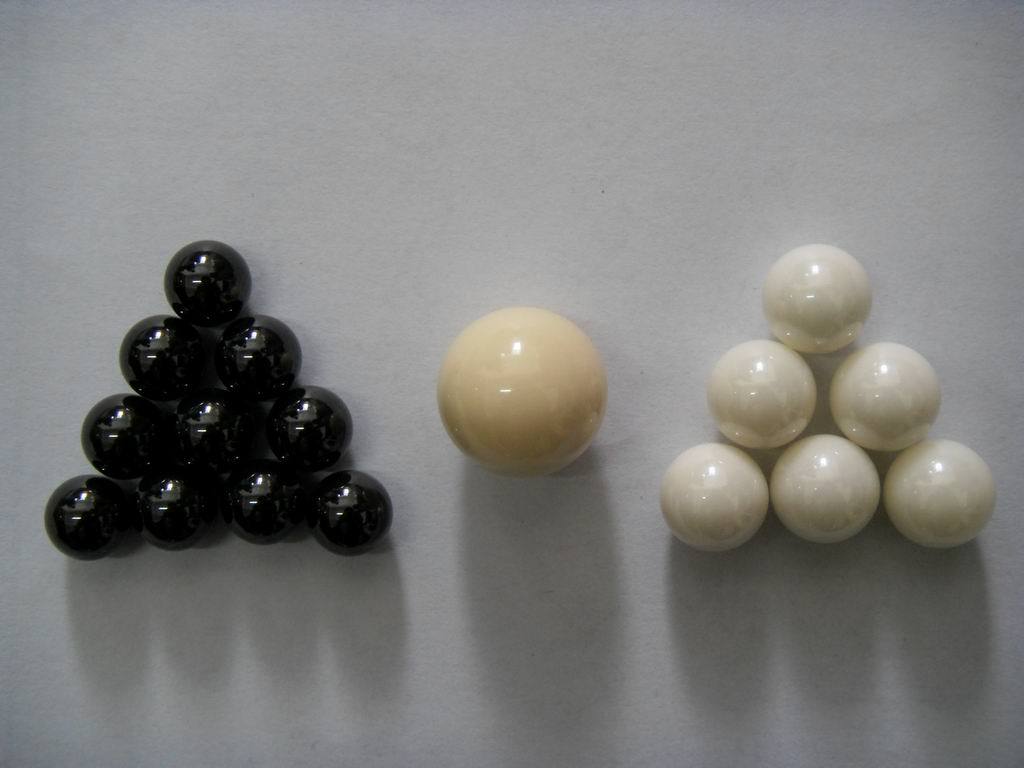
Material Specifications
| Â | Alumina Oxide | Zirconia Oxide | Silicon Nitride |
|---|---|---|---|
| Composition | 99.5% Al2O3Â / 0.5% other | 97% ZrO2Â / 3% MgO | 87% Si3N4Â / 13% other |
| Hardness | 1700 Hv | 80 - 84 Ra | 1400 - 1700 Hv |
| Ultimate Tensile Strength | 31,000 psi | 60,000 psi | - |
| Ultimate Compressive Strength | >300,000 psi | 285,000 psi | >570,000 psi |
| Modulus of Elasticity | 53 x106Â psi | 29 x106Â psi | 44-45 x106Â psi |
| Maximum Working Temperature | 1400ºC | 2400ºC | 1000ºC |
| Corrosion Resistance | Inert except for hydruofluric and hot concentrated sulphuric acids. | Inert to most substances, not recommended for environments of hydrochloric or strong alkaline solutions. | Inert to most substances. |
Description
These balls can be made from either Alumina Oxide, Zirconia Oxide or Silicon Nitride and have several advantages over their steel equivalents. They're 40% less dense than steel, have a 29% lower thermal expansion (so they hold their shape better when the temperature changes) and are 150% harder.
Benefits
Lightweight, hard and tough, with a low mass, these balls are particularly suited to environments which demand arduous, high speed bearing applications, for example machine tool spindles and vacuum pumps. Because they're so hard this reduces the amount of friction present and thus more of the energy is converted to work, making them more efficient; in some high-speed applications ceramic balls can last 100 times longer than steel. They're also inert (chemically inactive) to most substances, so they offer excellent corrosion resistance.
Use
You'll find these used in the automotive and aviation industries (their durability and light weight makes them perfect for use in aircraft braking assemblies for example) and they're often found in many of the items that once used more traditional metal balls, like aerosol paint cans, all manner of joints and slides (like car seats and safety restraints) as well as castors, ball transfer units, quick disconnect couplings and various kinds of fasteners.
Â

Material Specifications
| Â | Alumina Oxide | Zirconia Oxide | Silicon Nitride |
|---|---|---|---|
| Composition | 99.5% Al2O3Â / 0.5% other | 97% ZrO2Â / 3% MgO | 87% Si3N4Â / 13% other |
| Hardness | 1700 Hv | 80 - 84 Ra | 1400 - 1700 Hv |
| Ultimate Tensile Strength | 31,000 psi | 60,000 psi | - |
| Ultimate Compressive Strength | >300,000 psi | 285,000 psi | >570,000 psi |
| Modulus of Elasticity | 53 x106Â psi | 29 x106Â psi | 44-45 x106Â psi |
| Maximum Working Temperature | 1400ºC | 2400ºC | 1000ºC |
| Corrosion Resistance | Inert except for hydruofluric and hot concentrated sulphuric acids. | Inert to most substances, not recommended for environments of hydrochloric or strong alkaline solutions. | Inert to most substances. |
Description
These balls can be made from either Alumina Oxide, Zirconia Oxide or Silicon Nitride and have several advantages over their steel equivalents. They're 40% less dense than steel, have a 29% lower thermal expansion (so they hold their shape better when the temperature changes) and are 150% harder.
Benefits
Lightweight, hard and tough, with a low mass, these balls are particularly suited to environments which demand arduous, high speed bearing applications, for example machine tool spindles and vacuum pumps. Because they're so hard this reduces the amount of friction present and thus more of the energy is converted to work, making them more efficient; in some high-speed applications ceramic balls can last 100 times longer than steel. They're also inert (chemically inactive) to most substances, so they offer excellent corrosion resistance.
Use
You'll find these used in the automotive and aviation industries (their durability and light weight makes them perfect for use in aircraft braking assemblies for example) and they're often found in many of the items that once used more traditional metal balls, like aerosol paint cans, all manner of joints and slides (like car seats and safety restraints) as well as castors, ball transfer units, quick disconnect couplings and various kinds of fasteners.
Â
Construction lifts are usually used in combination with tower cranes on the construction site. The general load is 0.3-3.6 tons, and the operating speed is 1-96m/min. There are many types, which can be divided into two types according to the operation mode: non-paired weight and paired weight.
Construction elevator is often used in the construction of manned cargo construction machinery, mainly used in the city high-rise and super high-rise in all kinds of buildings, also known as construction elevator.
Construction Lift,Building Hoist,Construction Elevator,Heavy Duty Lifting Equipment
Jinan Shanghangda Machinery Co., Ltd. , https://www.jnwoodmachine.com